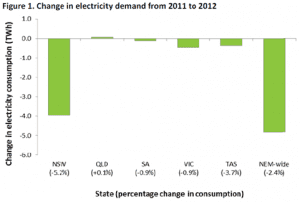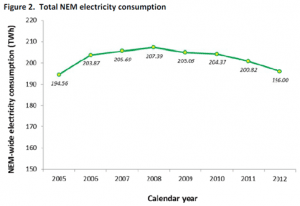Information released by the Australian Energy Market Operator (AEMO) on the National Energy Market (NEM), revealed that energy consumption has dropped for a fourth consecutive year, 2012 showing the largest annual reduction to date. Energy consumption in 2012 dropped by 4,818GWh (2.5%) on 2011 figures. This continued decline in consumption has surprised many, due to continued population and economic growth. To put the reduction of energy consumption in some perspective, 4,818 GWh is the equivalent of 740,000 homes no longer drawing any energy from the grid.
The NEM covers six jurisdictions – New South Wales, the Australian Capital Territory (ACT), Victoria, South Australia, Tasmania and Queensland. The latter being the exception to the rule, with energy consumption in the Sunshine State rising 0.15% on 2011 levels. New South Wales saw the most significant decrease in energy consumption of approximately 4,000 GWh (see figure 1).
Although there have been some environmental and economic drivers for this reduction in consumption (mild winters and the closure on energy plants being two examples), experts have cited residential solar PV, solar hot water systems and energy efficiency schemes, such as the Smart Grid, Smart City, as key to this reverse trend. Approximately 2,000 GWh of the reduction can be attributed to these schemes and the main player has been solar PV.
Figure 2 shows that the reduction in 2012 is part of an ongoing trend as energy consumption has fallen within the NEM states since 2008. This correlates to the rapid development of the solar PV market in association with generous Federal and State renewable energy incentives. At the end of 2011 we reported that solar PV had grown to 35 times the 2008 levels producing 680 gigawatt-hours (GWh) of clean energy, with ongoing interest and development in 2012 this figure is now likely to be much higher.
As a result of these findings and additional research, the AEMO announced at the beginning of December that less investment in the grid was needed. AEMO put the revised investment figure at $4 billion over the next 20 years as opposed to the original $7 billion estimate, it has also indicated that the focus should be on augmenting the main transmission network plus additional investment to replace ageing assets and augmentation to meet local demand growth.
Images via AEMO
© 2013 Solar Choice Pty Ltd
- NSW Club industry choosing solar power, with help from Solar Choice - 16 October, 2014
- 100% Renewables celebrates solar BBQ success - 26 February, 2013
- Coal fired power station in Queensland to be converted to ‘clean energy park’ - 21 February, 2013

